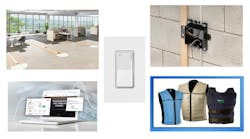Art. 430, Part XII provides the NEC requirements for the protection of the live parts of motor systems, regardless of the voltage. At less than a quarter page, Part 12 is the shortest Part of Art. 430.
The crux of it is stated at the outset: “Live parts shall be protected in an approved manner for the hazard involved” [430.231]. But this wording is potentially misleading. It isn’t the live parts you are protecting, it’s the people who may come into contact with those parts. The reason for this wording is you apply the protection to the live parts, not to the people.
For any motor with 50V or more between terminals, the live parts must be guarded against accidental contact with people [430.232]. That guarding can be accomplished by enclosure or location, by installing the motor:
- In a room or enclosure that is accessible only to qualified people.
- On a suitable balcony, gallery, or platform elevated and arranged to exclude unqualified persons.
- At an elevation 8 ft or more above the floor.
An exception applies to stationary motors that have commutators, collectors, and brush rigging located inside of motor-end brackets and not conductively connected to supply circuits operating at more than 150V to ground.
Obviously, guarding via location doesn’t protect operators or attendants. That’s where 430.233 comes in. It requires the use of suitable insulating mats or platforms situated such that the operator or attendant can’t readily touch live parts unless standing on one of these. You can see how this works if you draw out the circuit. The mat introduces a very high impedance at the feet of the operator or attendant, thus effectively reducing the amount of current that travels through hand, then arm, then heart, and so on out the feet.
However, for mats to work, they must be kept free of metal chips, oil, and other conductive material. That is why in machine shops you will often see something that looks like a packing crate for the operator to stand on. Even if the top surface became conductive, there’s a nonconductive material between it and the bottom surface plus there’s a considerable air gap between the surfaces.
Additional protective measures can be used, such as painting motors with nonconductive paint, using wood work tables or wood-covered metal tables, using nonconductive parts trays and carts, using nonconductive or insulated tools and jigs, using nonconductive metal chip buckets, and so on. These additional protective measures aren’t up to the electrician, but it is never a bad idea to point out to the owner or tenant why you applied Part 12 and why it’s important for them to eliminate as many conductive paths to humans as they can reasonably eliminate.




